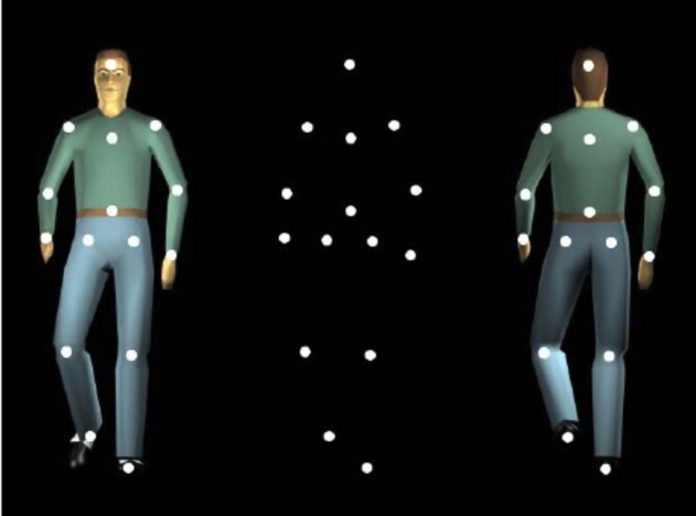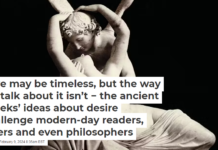
By Adam Heenan, Queen’s University, Ontario
We have a remarkable ability to detect the motion of other living things. If someone in our periphery moves, for example, our brains have evolved to detect that movement quickly and efficiently. This biological motion perception is so well developed that when we look at a series of dots used to represent the human figure placed at different parts of the body – called a point-light walker – we can tell many different things about that figure, such as their gender, mood, and even how stressed they are.
In most studies, point-light walkers are used to study how our brain detects this biological motion. But as a trainee clinical psychologist, I was interested in the ambiguity in depth. If you look at one of these figures facing towards you, for example, you have no way of knowing whether you are looking at the front or the back of it. Interestingly, when given this viewpoint, most people tend to perceive the walker as facing towards them, rather than away. This facing-the-viewer bias has been found repeatedly, and scientists think that it may exist for evolutionary reasons: that is, it’s safer to assume that an ambiguously oriented human figure is facing towards you rather than away.
Psychologists have found that when study participants are presented with figures that move in a more masculine way (less swing in the hip for example) it elicits greater facing-the-viewer biases than more feminine walkers. In addition, if you flip these figures upside down, observers are much less able to recognise them as representing humans and they no longer elicit a facing-the-viewer bias – they see these figures facing them just as often as facing away. This tells us that the facing-the-viewer bias has something to do with the social relevance of these figures, not simply just the pattern of the dots.
The threat bias
Anxious people display a very reliable bias towards threatening things in their environment. For example, if you display two pictures (one threatening and one neutral), more anxious people will attend to the threatening one first – the so-called “threat bias.” In our lab we found that more anxious people also had greater facing-the-viewer biases. The more anxious one was, the greater their bias.
In studies where experimenters try to reduce the threat bias (for example, via rewards), symptoms of anxiety are also reduced. Some researchers believe that this threat bias is a main contributor for why anxiety disorders are hard to kick — because the more anxious a person becomes, the more likely they are to attend to threatening things in their environment or threatening internal stimuli, like stressful thoughts. This helps perpetuate disorders and makes it harder to reduce stress.
In a study, published in PLOS ONE, we wanted to see this effect in action using point-light figures. We first tested whether exercise affected facing-the-viewer bias, since exercise is known to reduce anxiety. We had people either walk, jog, or stand (the control group) on a treadmill for ten minutes. We then had them sit at a computer and perform a perceptual task where we then measured their bias. We found that those who walked or jogged on a treadmill had significantly lower facing-the-viewer biases than those who just stood on the treadmill.
In a follow-up experiment, rather than exercise, we had people perform a progressive muscle relaxation task. This consisted of deep breathing while flexing and relaxing different muscle groups. Progressive muscle relaxation is known to reduce anxiety and is an effective treatment for some anxiety disorders. When we guided people to do progressive muscle relaxation for ten minutes, we found that their facing-the-viewer biases were significantly lower immediately afterwards, compared to a control group who did a simple word search task for the same amount of time.
We already knew that both exercise and progressive muscle relaxation can reduce anxiety. But now, our experiments show that these tasks also reduce the threat bias immediately afterwards (at least for human point-light walkers). While we don’t know how long this effect works for, this research adds to the considerable research showing that exercising and relaxing are positive things that people should strive to include in their lives. And although we need to explore it further, using point-walkers could be a great way to measure reductions in perceived threat after different activities.
![]()
Adam Heenan does not work for, consult to, own shares in or receive funding from any company or organisation that would benefit from this article, and has no relevant affiliations.
This article was originally published on The Conversation.
Read the original article.




















